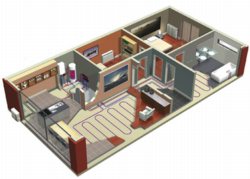The potential of heat pumps to reduce carbon emissions

A route to reducing carbon-dioxide emissions — a complete solution for heating and hot water in a home from an air-to-water heat pump is provided by Daikin’s Altherma system. The heart of the system is the Hydrobox in the small room on the back wall.
Underpinning the development by Daikin of a heating system for houses based on a heat pump is a careful analysis of its potential to massively reduce carbon emissions.As long as fossil fuels are implicit in heating houses, carbon dioxide will be emitted. That fact is inescapable, no matter how efficient boilers are becoming and how small the heating requirement of a house. In many countries in Europe, carbon-dioxide emissions associated with heating houses would be much reduced if electricity were used instead of gas-fired boilers. That perhaps surprising nugget of information comes from Philippe Vandesteene, a technical manager with Daikin Europe in Ostend, Belgium. The reason, he explains is that carbon-dioxide emissions associated with generating electricity in many European countries are very much lower than burning natural gas in a boiler. In Norway, the dominance of hydro-electricity means that carbon-dioxide emissions are only 3 g/kWh — compared with 217 g/kWh for a gas-fired boiler. In France, with its high proportion of nuclear electricity, carbon-dioxide emissions average 32 g/kWh, compared with 217 g/kWh for a gas-fired boiler — which is obviously the same in every country. In the UK and Germany, fossil fuels are widely used to generate electricity, so carbon-dioxide emissions are 442 and 517 g/kWh, respectively. Daikin’s interest in using electricity for heating stems from its expertise in air conditioning, which can readily be applied to heat pumps to provide space heating. And, as Philippe Vandesteene reminds us, heat pumps can typically deliver three times more heat than the amount of electricity they consume — and thus have the potential to reduce carbon emissions associated with electricity by two-thirds and trebling the benefit of electricity that is generated from nuclear and renewable sources. That is the background to Daikin’s development of a system based on air-to-water heat-pump technology to provide heating and hot water for houses. Called Altherma, it has been tested in trials in Norway and France. Air has been chosen as the heat source because it is universally available, unlike water and ground sources. The essence of the system is that the heat pump, sited outdoors, delivers heated water to an indoor Hydrobox. This unit handles the exchange of energy between the heat pump and the indoor water circuits serving underfloor heating and hot-water cylinder. The three Altherma units currently available are rated from 6.1 to 8.6 kW. Three larger models with outputs from 11.2 to 16.8 kW are to be introduced next year. Exploiting such heat-pump technology in the UK to replace a gas-fired heating system has the potential to reduce carbon-dioxide emissions by 42%, according to Philippe Vandesteene. In Germany, with its dirtier generation of electricity, the potential reduction is 32%. In France, replacing a gas-fired boiler with an Altherma heat-pump system could reduce carbon-dioxide emissions by 96% — because of nuclear generation. The saving is even greater in Norway — 98%. It is in France and Norway that Altherma has been put through its paces. The effectiveness of heat pumps declines as the temperature of the outdoor air falls, and Altherma responds to this by using backup electric heating at low temperatures — the ‘equilibrium’ point being selected to minimise overall costs. The heat pump can achieve domestic hot water at 50°C; higher temperatures are provided by an immersion heater. In Norway, Altherma was trialled in a 150 m2 well-insulated house. Underfloor heating is installed on the ground floor and in the bathroom upstairs. Fan-coil units provide heating elsewhere upstairs. The hot-water storage tank has a capacity of 300 litres. The seasonal COP of this project was 2.8, including DHW. Taking into account the backup electric heating, the COP was 2.6. The project in France involved a 2-storey house with heated floor areas of 200 m2. The walls are of brick, with no inner wall insulation. The seasonal COP, including DHW, was 3.4 — falling slightly to 3.2 when the consumption of the backup electric heating is taken into account. Philippe Vandesteene sees enormous potential for the Altherma concept against the background of the European market for heat pumps expected to more than double from 150 000 units in 2006 to about 340 000 units in 2014 (excluding air-to-air). Within those figures, the growth of air-to-water heat pumps is expected to be double that of water-to-water (including ground source).
For more information on this story, click here:
Dec 06, 75Related links:








